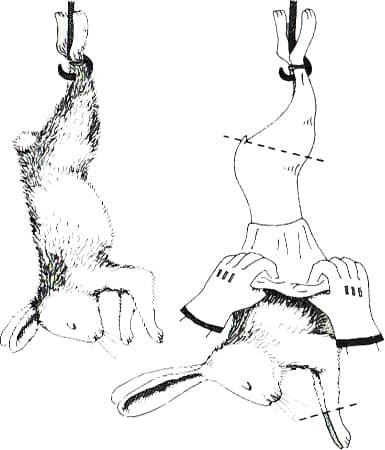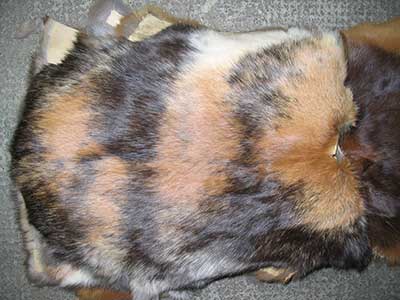As a young boy learning to hunt, I will never forget the experience of getting my first rabbit. Beebee gun slung over one shoulder, rabbit dangling in my other hand, I proudly made my way back to my great-grandmother’s house to show her my trophy.
I just had made it back to the yard of that rambling farmhouse, the rabbit beginning to cool, when I noticed a crawling sensation on my hand. I looked down and was horrified to find the rabbit was infested with fleas -and they were hopping off of the rabbit and crawling onto me.

I quickly dropped the rabbit, and ran into the house, wiping my hand on my pants the entire way. A short while later, accompanied by my great-grandmother, I returned to the rabbit. It laid right where I had dropped it, its body cold. The fleas were gone. As the body cooled, they had all fled, looking for a new host and warm meal.
Dealing with Fleas on Furbearer Hides
Every hunter and trapper must eventually face that vile and insidious parasite the flea. It may seem to be a laughing matter, but anyone who has ever experienced a flea infestation in their home understands how painful their presence can be and just how difficult to eradicate them.
The red welts from their painful bites can linger long after the last flea has been killed, which makes it all the more important to take cautionary steps to prevent the transfer of fleas from your latest hunting or trapping success to yourself and your home. As the saying goes, prevention is the best medicine.
Some animals are naturally prone to fleas, and even in the dead of winter when conditions are at their harshest and temperatures have plummeted, their fur can be host to thousands of these blood sucking pests. While you’re not likely to ever come across fleas on deer, if you tend to bring in coyotes, lynx, or rabbits (for example) you’ve very likely encountered these tiny brown creatures jumping off the animal once it begins to cool.
But, there are some things that you can do to limit your contact with the fleas and prevent them from finding their way into the house.
How to Get Rid of Fleas on Furbearer Hides
Traditional Methods
There are a few indigenous methods for dealing with fleas on furbearers that have enjoyed such a longstanding tradition due their effectiveness of ridding a prize hide of fleas.
One such is to place the flea-ridden animal on the ground, near a warm rabbit skin. As the animal cools, the fleas will abandon ship and retreat to the warm rabbit skin. After enough time has passed to ensure that all of the fleas have migrated, the rabbit hide will be thrown into a fire.

As rabbits are plentiful and a frequent food source, losing one hide isn’t that great of a loss compared with the gain brought by a premium fur, such as from a lynx or coyote.
Freezing
A favorite trick among many hunters, trappers, and taxidermists is to freeze the animal before starting to work on it. However, it is important to note that unless you freeze the animal for at least 24 hours, once it begins to thaw out the fleas, too, will thaw out and resume jumping around looking for something to bite.
That means if temperatures are cold enough outside (that means below freezing, just being cold isn’t enough) you can leave the animal outside–but where scavengers and less than well-behaved pets can’t get to it–and then bring it in, thaw it out, and get to skinning it.

Considering how tenacious fleas are, however, it is strongly advised to let that animal freeze for a few days to ensure that the fleas truly are dead.
Skinning is always recommended as soon as possible, as it will be easier and there is less likely to be any damage to the hide due to spoilage (from freezing and then unevenly thawing out).
I’m also a big fan of eating what I bring in, so skinning, gutting, and washing the meat as quickly as possible is especially important to me to prevent any spoiling of the meat. As such, I tend not to use this method but will leave especially flea-ridden hides outside till the fleas have abandoned it before bringing the hide inside or placing it with my other hides.
Chemicals
Some of the most effective methods for killing and removing fleas are chemical sprays and powders. While this particular method isn’t recommended if you intend on eating the meat of the animal, it is a fast and efficacious way of permanently removing the fleas.
For this method, you’ll need a plastic bag (like a garbage bag) free of holes and either flea powder or spray flea killer. You can get flea powder where pet supplies are sold whereas the spray flea killer may be in the same area or found with other insecticides.

Once you remove the animal from your trap or are retrieving it on your hunt, place the animal into the plastic bag and either sprinkle it with the flea powder or spray it thoroughly. In both instances, avoid inhaling the powder or spray and avoid contact with your skin. Seal the bag tightly and take the animal back to your base camp or home.
Allow the animal to sit in the bag for at least a good 20 minutes to give the chemicals a chance to kill all of the fleas. Wear gloves when removing the animal from the bag and when skinning it to avoid coming into contact with the chemicals. The smell should fade further as time passes, but you may want to consider working in a well-ventilated area.
The preservation and tanning process for the hide will take care of any residual chemicals on the hide, so it won’t affect the quality of the hide, your ability to use it for clothing or blankets, nor the price it brings you should you choose to sell it.
Final Thoughts: Dealing with Fleas on Furbearer Hides
Fleas are an awful part of hunting and trapping furbearers that everyone must eventually face. They can be frustrating and leave your skin crawling, but they’re not anything to be overly concerned with when it comes to the quality of the hide.
Getting rid of those fleas isn’t difficult, but it does involve a few extra steps before you can begin skinning and preserving that hide. By following the methods outlined above, you’ll ensure that you don’t transfer any fleas to your home–which your pets and family will be thankful for!